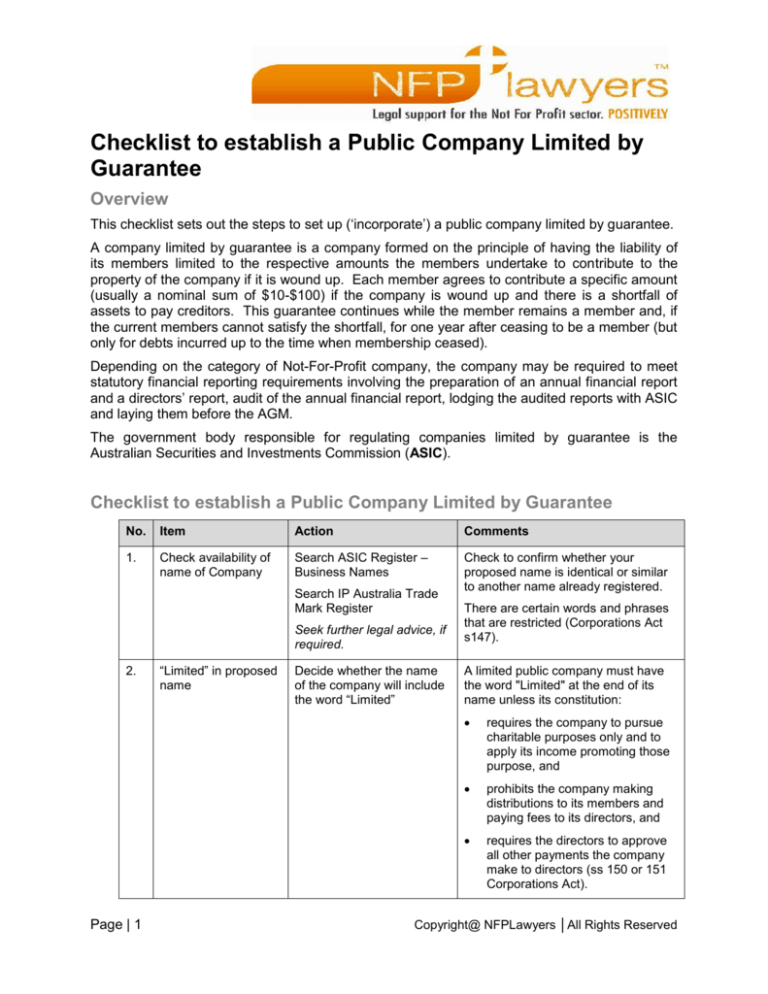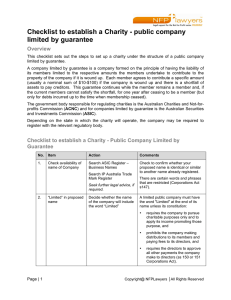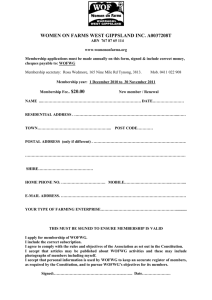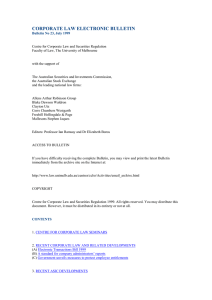
Checklist to establish a Public Company Limited by
Guarantee
Overview
This checklist sets out the steps to set up (‘incorporate’) a public company limited by guarantee.
A company limited by guarantee is a company formed on the principle of having the liability of
its members limited to the respective amounts the members undertake to contribute to the
property of the company if it is wound up. Each member agrees to contribute a specific amount
(usually a nominal sum of $10-$100) if the company is wound up and there is a shortfall of
assets to pay creditors. This guarantee continues while the member remains a member and, if
the current members cannot satisfy the shortfall, for one year after ceasing to be a member (but
only for debts incurred up to the time when membership ceased).
Depending on the category of Not-For-Profit company, the company may be required to meet
statutory financial reporting requirements involving the preparation of an annual financial report
and a directors’ report, audit of the annual financial report, lodging the audited reports with ASIC
and laying them before the AGM.
The government body responsible for regulating companies limited by guarantee is the
Australian Securities and Investments Commission (ASIC).
Checklist to establish a Public Company Limited by Guarantee
No.
Item
Action
Comments
1.
Check availability of
name of Company
Search ASIC Register –
Business Names
Check to confirm whether your
proposed name is identical or similar
to another name already registered.
Search IP Australia Trade
Mark Register
Seek further legal advice, if
required.
2.
Page | 1
“Limited” in proposed
name
Decide whether the name
of the company will include
the word “Limited”
There are certain words and phrases
that are restricted (Corporations Act
s147).
A limited public company must have
the word "Limited" at the end of its
name unless its constitution:
requires the company to pursue
charitable purposes only and to
apply its income promoting those
purpose, and
prohibits the company making
distributions to its members and
paying fees to its directors, and
requires the directors to approve
all other payments the company
make to directors (ss 150 or 151
Corporations Act).
Copyright@ NFPLawyers │All Rights Reserved
No.
Item
Action
Comments
3.
Reservation of
proposed name of
Company
ASIC Form 410 +
prescribed fee
The initial reservation is for 2 months.
This may be extended for 2 further
periods of 2 months by lodging
another ASIC Form 410 before the
previous reservation expires. The
second extension usually requires a
reason for the delay to be given.
4.
Constitution
Decide how the company
will be internally governed.
The internal governance may operate
under the replaceable rules, its own
constitution or a combination of both.
Draft proposed Constitution
Seek legal assistance in
drafting constitution.
5.
Consents of
proposed officers of
Company
Obtain written consents to
act and personal details of
initial directors and
secretaries (Corporations
Act ss201D, 204C and
205B).
Seek legal assistance in
drafting consent forms, if
required.
A table of the basic rules for internally
managing a company is set out in
s141 Corporations Act.
The consent usually includes
disclosures of interest in accordance
with Corporations Act Div2, part 2D.)
The company must have a minimum
of 3 directors, one of who must reside
in Australia (s201A Corporations Act).
There must be at least one secretary
resident in Australia (s204A
Corporations Act).
Keep a record of the consents – you
do not need to lodge the consents
with the registration application but
will need keep with company’s
records.
6.
Members
Identify the initial member/s
A limited public company must have
at least one member.
7.
Adopt Constitution
Initial member/s sign the
Constitution
Each member agrees to the
provisions of the constitution and to
pay the amount undertaken to
contribute to the property of the
company if it is wound up.
Keep a record of the agreements –
you do not need to lodged the
agreements with the registration
application but will need keep with
company’s records.
8.
Page | 2
Office address
Identify address of
registered office and
principal place of business
(ss142-146 Corporations
Act).
The address must be in Australia.
Copyright@ NFPLawyers │All Rights Reserved
No.
Item
Action
Comments
9.
Occupier’s consent (if
required)
Obtain occupier’s written
consent if the company will
not occupy the premises at
the registered office (s143
Corporations Act).
10.
TCC and DGR
Seek pre-endorsement
advice if the company is to
be a TCC and/or DGR.
It may be appropriate to apply to the
ATO for pre-endorsement advice that
the company will be eligible for
endorsement as a TCC when
incorporate. This may be done by
application in a letter with a copy of
the proposed constitution sent to:
Australian Taxation Office
Non-profit Centre
PO Box 300
Penrith NSW 2740
11.
Exemptions and
concessions
Seek advice in principle.
12.
Incorporation
After receiving preendorsement approvals in
principle, apply for
incorporation, ASIC Form
201 + prescribed fee.
The form may be lodged directly with
ASIC or mailed to:
A copy of the company’s
constitution must be lodged
with the form.
PO Box 4000
13.
Section 150 company
Apply to ASIC for approval
to be a section 150
company by lodging an
ASIC Form 432.
14.
Registration
After receipt of application
ASIC will:
Page | 3
give the company an
Australian Company
Name (ACN)
register the company;
issue a Certificate of
Registration.
Australian Securities and Investments
Commission
Gippsland Mail Centre
Vic 3841
Within 2 days of registration ASIC will
issue an 8 digit number associated
with the company’s ACN (known as
the ‘corporate key’). The corporate
key is used to register and view the
company records, lodge forms and
receive annual statements online.
Copyright@ NFPLawyers │All Rights Reserved
No.
Item
Action
15.
Special purpose
company
If applicable, check box on
ASIC Form 201 to indicate
‘special purpose company’,
alternatively apply to ASIC
by lodging an ASIC Form
484B.
16.
Auditor
Obtain written consent of
auditor.
17.
Company name
The Company’s name must
be displayed prominently at
every place at which the
company carries on
business that is open to the
public.
18.
First directors’
meeting to:
Convene meeting in
accordance with company’s
constitution.
19.
table
incorporation
documentation
open bank
accounts
appoint auditor
apply for ABN
decide financial
year (s323D
Corporations Act)
ABN and tax
endorsements
Comments
The directors of the company must
appoint an auditor within 1 month
after the day the company is
registered, unless the company in
general meeting appoints an auditor.
The auditor appointed by the directors
holds office until the first AGM (s327A
Corporations Act).
Seek legal assistance on
drafting minutes of first
directors meeting, if
required.
Apply for ABN and other
TCC and DGR
endorsements. ABN
application form – ATO
On receipt of relevant
application forms from
ATO, apply for
endorsement as a TCC and
DGR. Lodge form with
copies of Constitution and
pre-endorsement advice
letter.
Page | 4
Copyright@ NFPLawyers │All Rights Reserved
No.
Item
Action
Comments
20.
Bank accounts
Open bank accounts as per
directors’ resolution
21.
Insurance policies
Take out relevant insurance
policies
22.
Company records
and register
Maintain a register of
members.
Keep a record of all
directors’ and members;
meeting minutes and
resolutions
23.
First AGM
Convene and hold the first
AGM in accordance with
company’s constitution and
Corporations Act.
The first AGM must be held within 18
months after registration and
thereafter at least once in each
calendar year and within5 months
after the end of its financial year
(s250N Corporations Act).
The information contained in this checklist is intended as a guide only, and is not legal
advice. If you or your organisation has a specific legal issue, please seek legal advice
before making a decision about what to do.
Page | 5
Copyright@ NFPLawyers │All Rights Reserved












